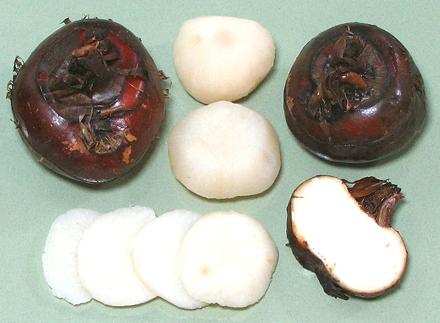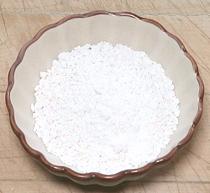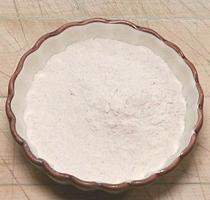 [Chinese Water Chestnut; Biki (China); Apulid (Philippine);
Cu ma they, Cu nang (Viet); Somwang (Thai); Singhada (India);
Eleocharis dulcis]
[Chinese Water Chestnut; Biki (China); Apulid (Philippine);
Cu ma they, Cu nang (Viet); Somwang (Thai); Singhada (India);
Eleocharis dulcis]
Water Chestnuts are native to China, Japan, India and Southeast Asia, the Philippines, Australia, Pacific Islands and tropical Africa. They are extensively farmed in Southern China and the Philippines, where they grow well in flooded rice paddies and lotus ponds.
Mature plants produce the underground "corms" we call Water Chestnuts as a means of propagation. Their crunchy texture and slight sweetness are appreciated in soups and stir fries. A notable feature is that they remain crisp and crunchy even after cooking or canning, making them a good texture accent.
Canned Water Chestnuts are very convenient, but the difference in taste between fresh and canned is amazing. For recipes where Water Chestnuts are a significant feature, you want fresh if at all possible.

Water Chestnuts contain a lot of starch, 60% by dry weight. This starch makes a particularly crisp coating for fried foods, much liked in Southeast Asia. It is also used as a thickener, and in China, is used to make some types of cakes and dumplings.
As a thickener, it is used particularly in clear soups, especially expensive Shark Fin Soup, because it is considerably more clear than Cornstarch. It is extremely neutral in flavor. It does have a slightly brown tint, but that wouldn't be noticed in a soup. It also has about 200% the thickening power of cornstarch and is very stable with boiling compared to most starches.
Buying: This starch is found in Asian markets and on-line.
The package should specifically say "Starch" and there should be Chinese
lettering, otherwise, you might be getting Flour.

[Singoda Flour (India); Farine de Macre Commune (French)]
This is a specialty of India, used by Hindu adherents worldwide during periods of fasting. During these times it replaces Besan (Chickpea Flour) which is much used in India but forbidden during fasting.
Water Chestnut Flour has a light brown color, has far less thickening
power than cornstarch, and would never be clear in a soup. It is used mainly
in baked goods and as a coating for fried foods. This product is important
to Indian communities, so can be easily found in Indian markets and on-line.
Water Chestnuts are about 90% dry weight carbohydrates, 60% of dry weight is starch. They are also significant sources of dietary fiber, riboflavin, vitamin B6, potassium, copper, and manganese.
In India and other parts of Asia where pigs are raised near where water chestnuts grow, eating them (or other aquatic plants) raw can convey the parasitic trematode worm Fasciolopsis buski. This is not a problem with canned water chestnuts, which are lightly cooked, or fresh ones sold in North America which are from commercial ponds, not from peasant farms.
sd_wchestz 161216 - www.clovegarden.com